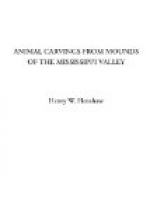To afford a means of comparison, Fig. 154, from the “Ancient Monuments” of Squier and Davis, is introduced (Fig. 8). The same figure is also to be found in Wilson’s Prehistoric Man, vol. i, p. 476, Fig. 22. Another of the supposed lamantins, Fig. 9, is taken from Squier’s article in the Transactions of the American Ethnological Society, vol. ii, p. 188. A bad print of the same wood-cut appears as Fig. 153, p. 251, of the “Ancient Monuments.”
It should be noted that the physiognomy of Fig. 6, above given, although unquestionably of an otter, agrees more closely with the several so-called manatees, which are represented without fishes, than with the fish-bearing otter, first mentioned, Fig. 4.
Fig. 6 thus serves as a connecting link in the series, uniting the unmistakable otter, with the fish in its mouth, to the more clumsily executed and less readily recognized carvings of the same animal.
[Illustration: Fig. 8.—Lamantin or sea-cow of Squier and Davis.]
[Illustration: Fig. 9.—Lamantin or sea-cow of Squier.]
It was doubtless the general resemblance which the several specimens of the otters and the so-called manatees bear to each other that led Stevens astray. They are by no means facsimiles one of the other. On the contrary, while no two are just alike, the differences are perhaps not greater than is to be expected when it is considered that they doubtless embody the conceptions of different artists, whose knowledge of the animal, as well as whose skill in carving, would naturally differ widely. Recognizing the general likeness, Stevens perhaps felt that what one was all were. In this, at least, he is probably correct, and the following reasons are deemed sufficient to show that, whether the several sculptures figured by one and another author are otters or not, as here maintained, they most assuredly are not manatees. The most important character possessed by the sculptures, which is not found in the manatee, is an external ear. In this particular they all agree. Now, the manatee has not the slightest trace of a pinna or external ear, a small orifice, like a slit, representing that organ. To quote the precise language of Murie in the Proceedings of the London Zoological Society, vol. 8, p. 188: “In the absence of pinna, a small orifice, a line in diameter, into which a probe could be passed, alone represents the external meatus.” In the dried museum specimen this slit is wholly invisible, and even in the live or freshly killed animal it is by no means readily apparent. Keen observer of natural objects, as savage and barbaric man certainly is, it is going too far to suppose him capable of representing an earless animal—earless at least so far as the purposes of sculpture are concerned—with prominent ears. If, then, it can be assumed that these sculptures are to be relied upon as in the slightest degree imitative, it must be admitted that the presence of ears would alone suffice to show that they cannot




